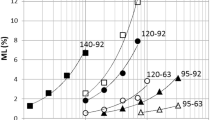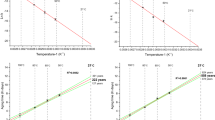Abstract
In this paper we present a time-temperature superposition method for predicting the permanence of paper by extrapolating accelerated paper ageing data to ambient conditions. The presented method includes a test for the presence of shift factors to superpose all of the raw accelerated ageing data over the temperature range studied to obtain a master curve, a numerical fit of the master curve for producing a master equation representing the kinetics of paper degradation, a critical examination of applying Arrhenius equation for explaining the relationship between the empirically determined shift factors and the accelerated ageing temperature, and a verification of the Arrhenius activation energy extrapolation assumption. Unlike the usual approach that extrapolates the Arrhenius relationship between lifetime and temperature, without corroborating evidence, to ambient temperatures, we test the Arrhenius activation energy extrapolation assumption by determining the influence of acidity on cellulose hydrolysis reactions, and have found that detection and identification of the acid-sensitive linkages in cellulose substances is an ultra-sensitive and reliable method to measure degradation of cellulose and paper in what is normally the extrapolation region (ambient temperatures). Taking the examples of natural ageing data in literature from 18 bleached kraft dry-lap pulps for 22 years under ambient conditions and three handsheet samples for 22 years under controlled conditions, comparison of the predictions with natural ageing results has been addressed.







Similar content being viewed by others
References
Arney JS, Jacobs AJ (1979) Accelerated aging of paper: the relative importance of atmospheric oxidation. Tappi J 62(7):89–91
Arney JS, Noval CL (1982) Accelerated aging of paper. The influence of acidity on the relative contribution of oxygen-independent and oxygen-dependent processes. Tappi J 65(3):113–115
ASTM D4243-86 (1986) Standard method for measurement of average viscometric degree of polymerization of new and aged electrical papers and boards
ASTM D1795-90 (1990) Standard test method for intrinsic viscosity of cellulose
Billmeyer FW (1984) Textbook of polymer science. John Wiley & Sons, NY
Browing BL, Wink WA (1968) Studies on the permanence and durability of paper. I. Prediction of paper permanence. Tappi J 51(4):156–163
Daruwalla EH, Narsian MG (1966) Detection and identification of acid-sensitive linkages in cellulose fiber substances. Tappi J 49(3):106–111
Ding HZ, Wang ZD (2005) Modelling the ageing of cellulose insulation in power transformers. In: 3rd IEE international conference on reliability of transmission and distribution networks (RTDN 2005). IEE Conference Publication (CP 508), London, UK, pp 315–319, 15–17 Feb. 2005
Ekenstam Aaf (1936) The behaviour of cellulose in mineral acid solutions: kinetic study of the decomposition of cellulose in acid solutions. BER 69:540–553
Emsley AM, Stevens GC (1994) Kinetics and mechanisms of the low temperature degradation of cellulose. Cellulose 1:26–56
Erhardt D, Mecklenburg MF (1995) Accelerated vs. natural aging: effect of aging conditions on the ageing process of cellulose. Materials Research Society Symposium-Proceedings 352:247–270
Gillen KT, Clough RL (1989) Time-temperature-dose rate superposition: a methodology for extrapolating accelerated radiation aging data to low dose rate conditions. Poly Deg Stab 24:137–168
Gillen KT, Celina M (2001) Wear-out approach for predicting the remaining lifetime of materials. Poly Deg Stab 71:15–30
Gillen KT, Celina M, Keenan MR (2000) Methods for predicting more confident lifetimes of seals in air environments. Rubber Chem Technol 73(2):265–283
Gillen KT, Bernstein R, Derzon DK (2005) Evidence of non-Arrhenius behaviour from laboratory aging and 24-years field aging of polychloroprene rubber materials. Poly Deg Stab 87:57–67
Gurnagul N, Howard RC, Zou X, Uesaka T, Page DH (1993) The mechanical permanence of paper: a literature review. J Pulp Paper Sci 19(4):J160–J166
Leaderman H (1943) Elastic and creep properties of filamentous materials and other high polymers. The Textile Foundation, Washington DC
Michie RIC, Sharples A, Walter AA (1961) The nature of acid-sensitive linkages in cellulose. J Polymer Sci 51:85–98
Porck HJ (2000) Rate of paper degradation: the predictive value of artificial aging tests. European Commission on Preservation and Access, Amsterdam
Roberson DD (1976) The evaluation of paper permanence and durability. Tappi J 59(2):63–69
Scandinavian Pulp, Paper and Board Testing Standard (1962) Viscosity of cellulose in cupriethylenediamine (CED) solution. SCAN-C15:65
Sharples A (1954) The hydrolysis of cellulose, Part II. Acid sensitive linkages in Egyptian cotton. J Polymer Sci 14:95–104
Smith RD (1969) Paper impermanence as a consequence of pH and storage conditions. Library Quart 39(2):153–195
Wise J, Gillen KT, Clough RL (1995) An ultrasensitive technique for testing the Arrhenius extrapolation assumption for thermally aged elastomers. Poly Deg Stab 49:403–418
Zou X, Gurnagul N, Uesaka T, Bouchard J (1994) Accelerated aging of papers of pure cellulose: mechanism of cellulose degradation and paper embrittlement. Poly Deg Stab 43:393–402
Zou X, Uesaka T, Gurnagul N (1996a) Prediction of paper permanence by accelerated ageing I. Kinetic analysis of the aging process. Cellulose 3:243–267
Zou X, Uesaka T, Gurnagul N (1996b) Prediction of paper permanence by accelerated ageing II. Comparison of the predictions with natural aging results. Cellulose 3:269–279
Acknowledgements
The authors would like to thank all reviewers and Professor Wolfgang Glasser (Editor in Chief) for helpful comments and suggestions. We would also like to thank Dr Xuejun Zou of Pulp and Paper Research Institute of Canada for kind permission to use their published data in Zou, X., Uesaka, T. and Gurnagul, N. (1996 a, b).
Author information
Authors and Affiliations
Corresponding author
Rights and permissions
About this article
Cite this article
Ding, HZ., Wang, Z.D. Time–temperature superposition method for predicting the permanence of paper by extrapolating accelerated ageing data to ambient conditions. Cellulose 14, 171–181 (2007). https://doi.org/10.1007/s10570-007-9114-3
Received:
Accepted:
Published:
Issue Date:
DOI: https://doi.org/10.1007/s10570-007-9114-3




